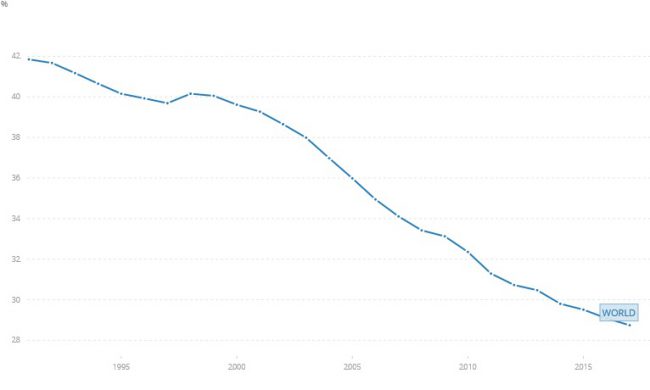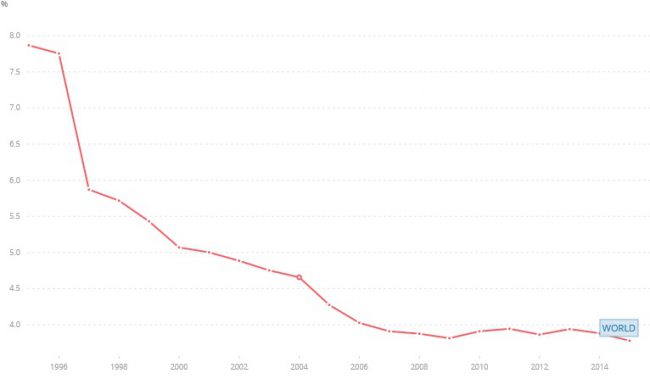My last five blogs (starting on February 20, 2018) have focused on some key indicators of the global energy transition as they relate to climate change and the IPAT identity. I examined the 12 most populous countries, which together represent more than half of the world’s population as well as the full spectrum of economic development. I also looked at five small, developed countries that are at the forefront of the transition into a more sustainable energy mix. I presented almost all of the indicators in this series on a per person basis so that we could compare countries with different populations.
This blog will open a new series that will present both the global picture and the specific data for the same set of countries in terms of vulnerabilities. Over the nearly six years since I started this blog, I have repeatedly mentioned that the main driving force for climate change is our disruption of the global energy cycle through our energy use. Most of the biggest impacts have occurred via our disturbance of the global water cycle. I have also said that this is not just about our future; there are early signs of impacts that are already taking place.
The vulnerabilities that we will talk about are existential but they do not take place uniformly throughout the planet. As a result, many people are trying to escape from vulnerable areas to more stable ones. Since our global governance system relies on sovereign states, the flux of environmental refugees is now awakening jurisdictional issues that never occurred to most of us (especially in light of the increasing number of political refugees). This series of blogs will mix the vulnerabilities to changes in the climate with the rise in people leaving their climate-affected countries in search of safer places for themselves and their families – often against the wishes of their target countries.
I am starting here with four important water-related indicators: employment in agriculture (% of total employment); agricultural value added; annual fresh water withdrawal (% of internal resources); and population living in areas where elevation is at or below five meters above sea level (% of total population). I am sourcing all of my statistics from the World Bank database.
Figures 1 and 2 show the global trend in the first two indicators over the last 20 years. We see a sharp decline both in terms of global employment in agriculture and in the fraction that agriculture contributes to GDP. The trend, coupled with the large increase in global population that took place over the same period strongly suggests that the agricultural industry is becoming much more efficient in feeding the growing global population.

Figure 1 – Global employment in agriculture (% of total employment)

Figure 2 – Global agricultural value added (% of GDP)
However, when we refocus our attention to individual countries, the situation changes.
Table 1 – Indicators of water-related vulnerabilities to climate change impact among the world’s most populous countries
Table 2 – Same indicators as in for five small, developed countries that are ahead in their energy transitions
Agriculture is very sensitive to climate conditions, especially when it is dependent on natural precipitation. Rich countries can produce food using many fewer workers and the activity constitutes a small part of the GDP. In poor countries the situation is markedly different. A large percentage of the employment in countries such as India (44%), Indonesia (31%), Pakistan (42%), Bangladesh (41%), Ethiopia (71%), and DR Congo (65%) is agricultural. When long-term droughts hit, people are driven from their plots. They must move to places that give them better chances of survival. In the same line, extraction of fresh water from nonrenewable sources reaches (or exceeds) dangerous levels in poor countries that lack the resources to supplement their water with sources such as desalination. I will expand on the issue of regional water stress in future blogs.
Annual fresh water withdrawal can exceed 100% when extraction from nonrenewable sources becomes significant (this correlates with water stress). The last column maps the percentage of the population that lives below 5 meters above sea level – those most susceptible to climate change-driven sea level rise. Nine percent of the population of Bangladesh amounts to 15 million people vulnerable to perpetual flooding threat. In China the 7% of the population in these circumstances amounts to a staggering 100 million people.
My next blog will focus on some of the global consequences behind these numbers.

When the average person considers taking personal actions to help mitigate climate change they primarily think about using public transportation more frequently, turning off the lights, and taking shorter showers, etc. However, they hardly ever contemplate the larger economic schemes in which they participate such as industrial-scale food production. Although food is not seen as a ‘natural resource’ in the same way that water or wood is, its cultivation and distribution requires an immense amount of energy consumption that is conveniently hidden (and ignored) behind its multi-step processing. An example of this is the relationship between commodity corn and the beef industry. The industrial food chain is powered by fossil fuel because of its large-scale structure that has consolidated farmland for the sake of efficiency and cheap food. Corn is grown as a monoculture not because it is in high demand but because the U.S. has figured out how to grow it easily and manipulate it for just about any use. Corn is grown all around the country and trucked to processing plants. Then, it is trucked to Concentrated Animal Feeding Operations, for example, where it is fed to cattle who are slaughtered and transported to grocery stores from coast to coast. This series of steps incurs environmental costs in energy use, toxic waste production, and nutrient depletion. It is estimated that to grow one steer to slaughter weight it takes approximately 25lb of corn per day which is a consumption equivalent to 35 gallons of oil. A major issue is the separation of steps involved in industrial farming compared to smaller-scale operations that are more holistic and oversee from start to finish. If we want to take a major step in mitigating climate change, we must propose a dramatic change in the way Americans purchase and consume food. Supporting local, small-scale farmers retains profits in the community and reduces petroleum consumption because our food is travelling fewer miles. Supporting farmers who are thoughtful in the way they operate and utilize their land protects local ecosystems to keep the environment in balance. A significant statistic is that if the sixteen million acres of cropland currently used to grow corn and grain to feed cattle was transformed back to pasture, it would remove fourteen billion pounds of carbon from the atmosphere which would be equivalent to removing four million cars off of the roads.
Regarding water—–water is essential to humans even moreso than food. It is said that humans can survive for a couple of months without food, but only a week or less without water. To insure that we will always have a supply of fresh water, I think that all countries should immediately start to build ocean water desalinization plants NOW, and even if they’re not used immediately, ascertain that they are in operating conditio0n so that, if needed in the future, than can be immediately put into operation should there be a water shortage and if the need for fresh water arises. Build these plants NOW and have them ready for operation at any time!
Regarding employment in agriculture—–in order to get more people into agriculture, they must have an interest in it. In order to get an interest in it, colleges and universities should offer various courses in agriculture—courses in botany, horticulture, entomology, agronomy, crop genetic engineering, soil science, soil microbiology, gardening, plant physiology, etc.
Colleges and Universities in big cities offer very few, if any of such courses! How many of these courses do we ever see offered at Brooklyn College, for example????
So, if we want to entice more students into agricultural fields as possible careers, we must offer more courses in these areas in order to attract their interest!